Saturday May 4, 2024
Williams Center for the Arts
8:00 pm
Program
Americans We (1929)
Henry Fillmore (1881 – 1956)
Americans We, first published in 1929, is as happy a piece of music as I know. Fillmore dedicated it “to all of us,” and he meant it. It forms one third of that great triad of marches that are the basis of our patriotic inspiration in this positive and traditional source of such an elusive, personal ingredient. The three marches are, of course, Fillmore’s Americans We, Bagley’s National Emblem March and Sousa’s The Stars and Stripes Forever.
Americans We teams with his other great march, His Honor March, … to represent Henry Fillmore to all of those people he so sincerely wished to make happy with his music. And highest on his list of those Americans whom he wished to reach with his “old-fashioned patriotism” are the never-ending thousands of young high school band musicians all over the Republic who are its ever-developing present and future.
When you play this new edition of this truly great American march classic, please remember that Henry Fillmore always had more fun with his music — than anybody.
– Program Note by Frederick Fennell
Rest (2011)
Frank Ticheli (b. 1958)
Frank Ticheli’s Rest is an adaptation for wind ensemble of his choral work entitled There Will Be Rest. The original choral work sets a strikingly poignant poem by Sara Teasdale (1884 – 1933):
There will be rest, and sure stars shining
Over the roof-tops crowned with snow,
A reign of rest, serene forgetting,
The music of stillness holy and low.
I will make this world of my devising,
Out of a dream in my lonely mind,
I shall find the crystal of peace, above me
Stars I shall find.
Of his wind ensemble adaptation, Ticheli writes:
“Created in 2010, Rest is a concert band adaptation of my work for SATB chorus, There Will Be Rest, which was commissioned in 1999 by the Pacific Chorale, John Alexander, conductor.
“In making this version, I preserved almost everything from the original: harmony, dynamics, even the original registration. I also endeavored to preserve carefully the fragile beauty and quiet dignity suggested by Sara Teasdale’s words.
“However, with the removal of the text, I felt free to enhance certain aspects of the music, most strikingly with the addition of a sustained climax on the main theme. The extended climax allows the band version to transcend the expressive boundaries of a straight note-for-note setting of the original. Thus, both versions are intimately tied and yet independent of one another, each possessing its own strength and unique qualities.
“The wind ensemble adaptation was commissioned by Russell Mikkelson and family in memory of his father, Elling Mikkelson.”
—
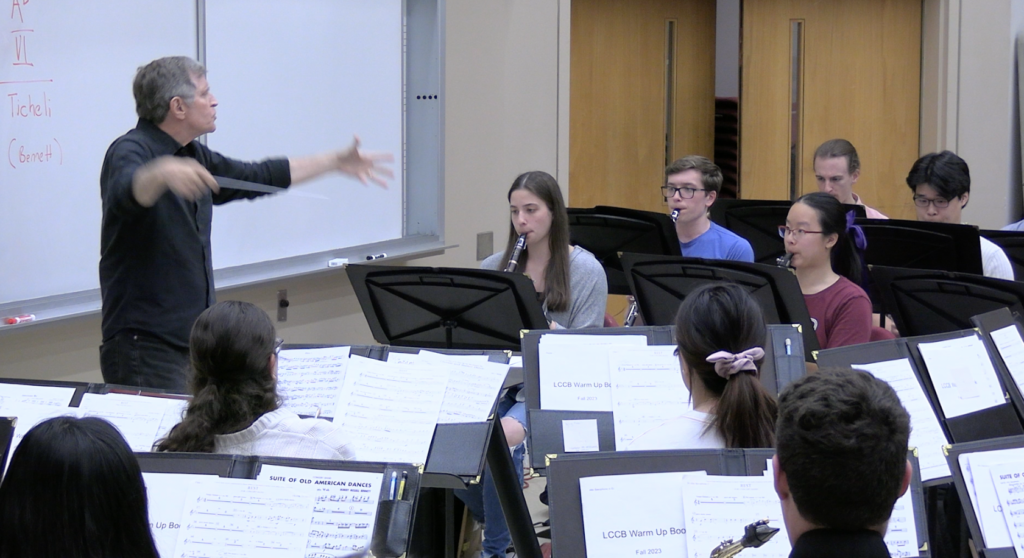 LCCB was very fortunate to host Prof. Ticheli for a rehearsal on April 6 . We had a terrific session with him–he put the band through its paces in his always positive and inspiring way. It was an intense rehearsal, and I was so happy with how focused, attentive, and flexible our players were. Ticheli brought us to another level of understanding on his beautiful piece, and we are grateful for his enthusiasm and energy.
LCCB was very fortunate to host Prof. Ticheli for a rehearsal on April 6 . We had a terrific session with him–he put the band through its paces in his always positive and inspiring way. It was an intense rehearsal, and I was so happy with how focused, attentive, and flexible our players were. Ticheli brought us to another level of understanding on his beautiful piece, and we are grateful for his enthusiasm and energy.
Special thanks to Darin Lewis, Visiting Assistant Professor of Music and Direcotr of Bands at Lehigh University for sharing Prof. Ticheli with us during Ticheli’s week-long residency at Lehigh.
Heroes, Lost and Fallen (1989)
David Gillingham (b. 1947)
Heroes Lost and Fallen (A Vietnam Memorial) is a tone poem for symphonic band based on the following poem by the composer:
Banish our thoughts
From this grueling war.
Let Suffering and Death
Rule no more.
Resolve this conflict
In hearts so sullen
And bring eternal peace
To the heroes, lost and fallen.
The work opens with an air of mysteriousness on a sustained sonority by bowed vibraphone with marimba tremolo. There are interspersed motives suggesting trumpet calls and quotes from the Star-Spangled Banner and the Vietnamese National Anthem. This beginning section reflects the uncertainty and instability before war. Following is a warm and consonant chorale in the low brass alluding to the world ideal of peace and serenity. This section segues into a sort of slow “march to war”. Just as the realization of the inevitability of war increases, so does this section increase in dynamic and dissonant intensity. Climaxing the section are quotes from the Star-Spangled Banner and Taps.
The ensuing section expresses the war itself with driving rhythms, dense textures, chaotic accompanimental motives and sinister themes. Growing in intensity, the section culminates with haunting “trumpet calls” alternated between trumpets and horns followed by four hammered articulations of a tone cluster. A thunderous roll of drums then elides into the next section where the consonant choral of “peace” reasserts itself, this time amidst the continuing conflict of war, suggesting that somehow “Good” will triumph over “Evil”. Both the chorale and the conflicting forces fade away, and a short dirge-like section follows based on the opening motive of the chorale, signifying destruction, death and aftermath. But the ever-present force of “Good” emerges and a serene yet powerful theme is stated, beginning in the horns. The theme grows to a glorious climax, diminishes and settles into C Major, the “key of the earth”. A unison “C”, with underlying tumultuous articulations by the drums, culminates the work … the drums reminding us that the threat of war will always be present.
Notes from the published score.
Intermission
Chorale and Shaker Dance (1972)
John Zdechlik (1937 – 2020)
John Zdechlik’s Chorale and Shaker Dance has become a staple of the wind ensemble repertoire since its first performance at the 1972 Music Educators National Convention. It was commissioned by Jefferson High School Band (Bloomington, MN), but premiered by the Medalist Concert Band (a community band also based in Bloomington) under the composer’s direction.
Zdechlick did not provide us with much in the way of program notes, adding only this to the score:
“Chorale and Shaker Dance is made up of two main ideas. The first is the simple melody found in the opening Chorale. The second melodic idea is the melody from the well-known Shaker Hymn The Gift to Be Simple.”
The hymn is indeed well known, and perhaps best so for its incorporation into Aaron Copland’s 1944 master piece, Appalachian Spring. There, Copland sets the tune in a series of variations which evoke memories of a simpler, distinctly American time long before the horrors of the Second World War. Zdechlik treats the tune much differently: here the hymn is given a more modern harmonic underpinning while its melodic ideas are sometimes fragmented, re-ordered, and re-contextualized. Its overall effect pays homage to Copland while at the same time seeks to carve its own path through the fertile ground of the original Shaker hymn.
Suite of Old American Dances (1949)
Robert Russell Bennett (1894 – 1981)
I. Cake Walk
II. Schottische
III. Western One-Step
IV. Wallflower Waltz
V. Rag
This piece is an homage to dances that Robert Russell Bennett grew up with. There are five movements which are all interpretations of dances and premiered with Bennett conducting it in Central Park on June 17, 1949. The program notes from the initial performance show what Bennett had in mind for the creation of this piece:
“As far as notes for the program are concerned, there’s no particular purpose in mind in the composition of the Suite except to do a modern, and, I hope, entertaining version of some of the dance moods of my early youth. Another equally important purpose was to do a number without any production tie-up such as World’s Fairs and municipal pageants, for symphonic band, and particularly for your band [the Goldman Band].”
He wanted to create a piece for American concert bands that had sounds that were not explored in that instrumentation yet. He was inspired by his youth in Kansas City and originally named the suite Electric Park, after an amusement park with the same name. “The tricks with big electric signs, the illuminated fountains, the big band concerts, the scenic railway and big dance hall — all magic. In the dance hall all afternoon and evening you could hear the pieces the crowds danced to, and the five movements of my piece were samples of the dances of the day.”
The first movement called the Cake Walk is named after an infamous American dance that dates back pre-Civil War. Originally, this dance had an unfortunate history as it was originally performed by enslaved people on plantation grounds. It was known as a “prize walk” as the prize was a cake, which is where the original source of phrases such as “takes the cake” comes from as well. Couples would stand in a square formation with men on the inside and then the women would dance around the men. It included “a high-leg prance with a backward tilt of the head, shoulders, and upper torso.” Plantation owners judged the contests and were not aware that the enslaved people were mocking them during these elaborate dances.
Even though the history of the Cakewalk is stained with the legacy of American slavery, enslaved people took back the Cakewalk for themselves and turned it into a form of mockery of white society. The cakewalk was so ingrained in American popular culture that once slavery ended, competitions still continued and the Cakewalk was still performed by white and black people alike. As popularity spread, it gave rise to its own form of music, which can be interpreted as an early form of ragtime. Legendary composers like Scott Joplin mention cakewalks and the connection to ragtime in his song “The Ragtime Dance.”
The second movement, II. Schottische, is an extraordinary example of multiculturalism in the United States. Schottische actually originated from Germany and was brought to the Americas by German settlers. There are variations throughout the United States, Latin America, Europe, and Australia. The schottische was popular in the Victorian era ballrooms and is made up of two side steps, right and left, followed by a turn in four steps. In New Orleans, during the development of ragtime and jazz, many bands would include variations of the schottische. This was to appeal to the older generations in the early 1900s. In Texas, the schottische also developed with new German settlers. The Mexican and Spanish song combinations with the waltz, polka, and schottische dance music was called musica norteno (music of the north) or conjunto (ensamble).
The One-Step was a very popular ballroom dance in the twentieth century partly because of its simplicity. According to Margaret West Kinney and Troy Kinney in the book “The Dance; Its Place in Art and Life” the One-Step originated from the Turkey Trot which took North America by storm. There are many variations of the One-Step but there is not a specifically a “Western” version, which is why this movement’s name is a little confusing. Fredrick Fennell says “[t]he composer informed me that this is also a dance known as the Texas Tommy.” There is not much information about the Texas Tommy, however it is believed to have originated in saloons and brothels.
The past two movements represent twentieth century dances that appeared in the United States, while the Wallflower Waltz shows how classics still had a strong influence in the ballroom dance scene. Even though new dance steps and a new cultural era were on the horizon, the time-honored tradition of the famous Waltz steps still was heard throughout the twentieth century in the United States.
The last movement is a Rag which has no specific dance that is associated with it. This choice however is more representative of this era as a whole. Ragtime boomed with the beginning of the century and there are adaptations of the steps above in a ragtime style as well. This seems fitting to end the suite as it represents the music of the age that he grew up in. Ultimately, it seems like a proper way to show his childhood in dances and music and a fitting conclusion to his Suite.
Notes by Samantha Semsel ’25
The Lafayette College Concert Band
Flute
Brian Morris
, Principal**
Iris Peluso
Jenna Tempkin, Associate Principal
Lauren Kaye
Jamie Lin (piccolo)
Oboe
Olivia Hoffman
Olivia Bamford
Nicole Bagdasarian (english horn)
Clarinet
Emily Rice, Principal**
Priscilla Wu
Ashley Kushner-Kmetz
Matthew Olson
Sungbum Lee
Greer Marvel
Christopher Ruebeck
William Cassidy
Aram Ramsay
Peter Rice (bass)
Bassoon
Sean Catarroja
Katie Rice
Saxophone
Julia Sealing, Principal (alto)**
Andrew Manni (alto)
Samuel Owens (alto)
Alex Kmetz (alto)
Chloe Williams (tenor)
Kevin Ding (tenor)
Caleb Fossett (baritone)
Horn
Madeline Paguia
Anastasia Krial-Victor
Gavin Davis
Trumpet
Drew Borek, Principal
Susanna Hontz, Associate Principal
Devin Arnold
William Blair
Josh Freiheiter
Kenneth Ho
Trombone
Pedro dos Santos
Jackson Eshbaugh
Benjamin Zwicker
Christopher Taverner (bass)
Euphonium
Ryan Pignotti
Tuba
Jack Kerekes, Principal (low brass)
Percussion
Casey Alexander
Joe Freeston
Gareth Schuster
Yuko Tanaka
Craig Mandelbaum
Piano
Yuko Tanaka
Graduating Seniors
Lafayette Faculty
LCCB Alumni
Guest Performers
**Creative and Performing Arts (CaPA) Fellows
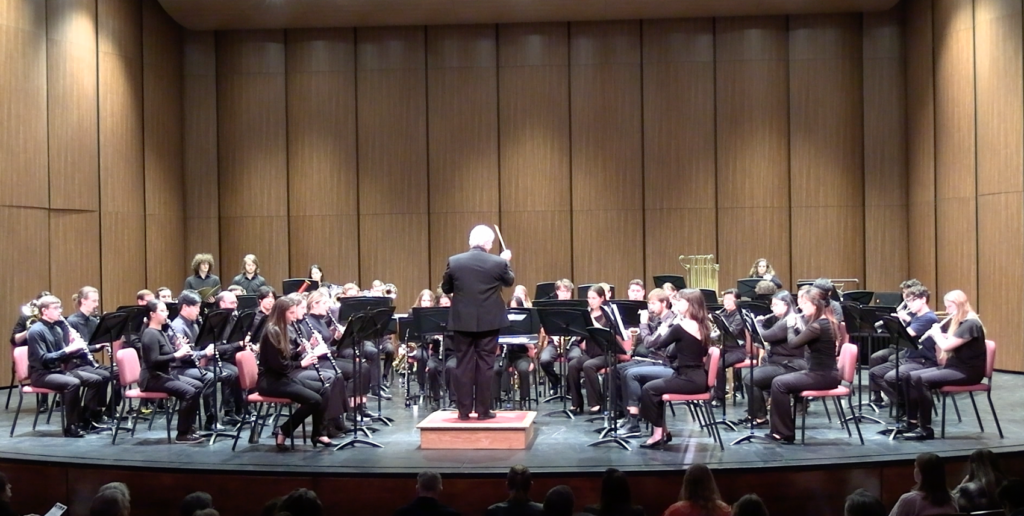 The Lafayette College Concert Band is comprised of approximately 50 students from a variety of majors who are united by a strong desire to perform the highest quality music at the height of their abilities. Participation in LCCB is open to students in any major as well as faculty and staff. The ensemble is conducted by Kirk O’Riordan, Associate Professor of Music.
The Lafayette College Concert Band is comprised of approximately 50 students from a variety of majors who are united by a strong desire to perform the highest quality music at the height of their abilities. Participation in LCCB is open to students in any major as well as faculty and staff. The ensemble is conducted by Kirk O’Riordan, Associate Professor of Music.
LCCB typically performs one concert each semester. The repertoire is selected from traditional concert band masterpieces, newer works by established and emerging composers, commissions, and orchestral transcriptions. Past concerts have included works such as Husa’s Music for Prague 1968, Bernstein’s Symphonic Dances from West Side Story, both Holst Suites, Grainger’s Lincolnshire Posy, and Mussorgsky’s Pictures at an Exhibition. LCCB has premiered works by composer/conductor Kirk O’Riordan and 2010 Pesky Artist in Residence William Pfaff as well as Ashley Kushner ’19 and Zach Jones ’13.
Students enroll for 1/4-credit. Open to all students, faculty and staff, LCCB employs a wind ensemble model for instrumentation. A seating audition is required before the first semester of participation. Due to the large numbers of flutists, clarinetists, saxophonists, and trumpeters, the number of available seats in these sections may be limited.
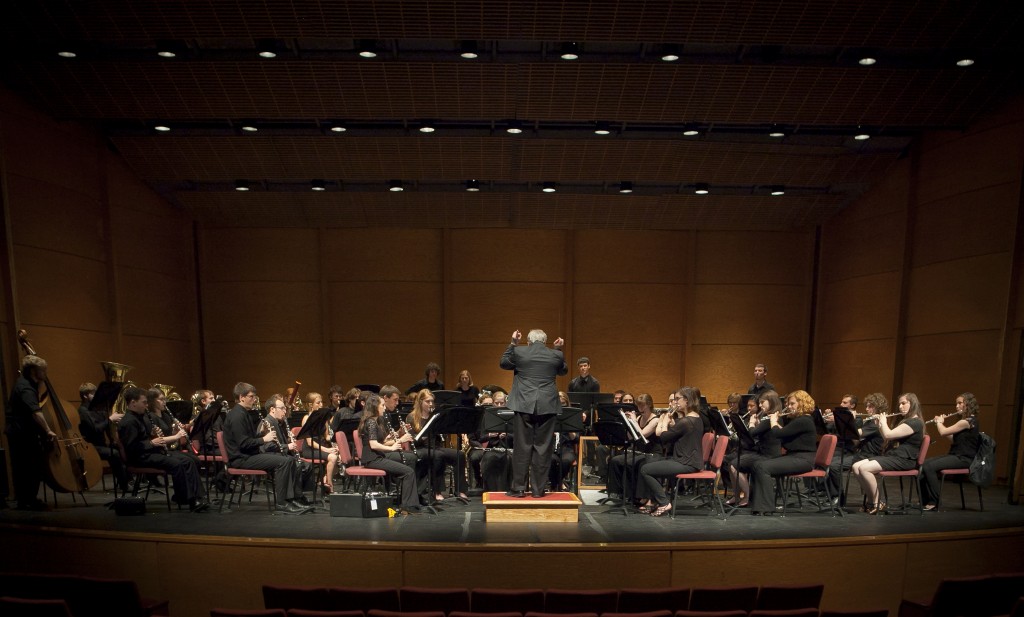 Several opportunities for leadership in the ensemble are available for highly motivated, experienced players. Principals in each section lead sectional rehearsals and help the less experienced players with technical issues. The Assistant Conductor is a highly advanced musician who has been studying conducting for at least one year prior to serving in the position. She/he conducts the ensemble on at least one piece in performance, having led all the rehearsals for that performance. Typically, that person also leads Pep Band and conducts the annual Marquis Players musical production. Finally, the LCCB President is nominated and elected by the student membership of the ensemble. This person works with the director and the Assistant Conductor on administrative tasks as a representative of the students.
Several opportunities for leadership in the ensemble are available for highly motivated, experienced players. Principals in each section lead sectional rehearsals and help the less experienced players with technical issues. The Assistant Conductor is a highly advanced musician who has been studying conducting for at least one year prior to serving in the position. She/he conducts the ensemble on at least one piece in performance, having led all the rehearsals for that performance. Typically, that person also leads Pep Band and conducts the annual Marquis Players musical production. Finally, the LCCB President is nominated and elected by the student membership of the ensemble. This person works with the director and the Assistant Conductor on administrative tasks as a representative of the students.
Blurred Days CD
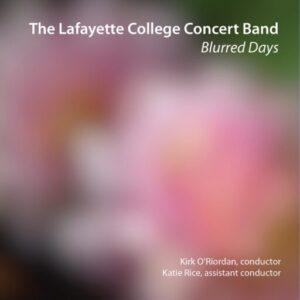 Like many bands and other performing ensembles across the country, we have had to adapt to the pandemic. For us, this has meant that we have not been able to work together, in person. This has always been a band that thrives on its sense of community, and not having that has been hard on all of us.
Like many bands and other performing ensembles across the country, we have had to adapt to the pandemic. For us, this has meant that we have not been able to work together, in person. This has always been a band that thrives on its sense of community, and not having that has been hard on all of us.
But rather than mourn what we have lost, we have searched for opportunities within our remote format that are unique. Working in isolation has allowed us to re-examine the possibilities of the Wind Ensemble as an entity—to re-imagine what is possible with this collection of sounds.
The five pieces on this CD were written especially for us, and especially for our situation. Each of the pieces was conceived to take advantage of techniques that would not be possible in a traditional concert—effects on a person-by-person level, or writing for flutes in their lowest register.
To make these performances, each student recorded his or her part on their phones or computers and uploaded them to either a shared drive or to the web-based recording service Band Lab. Katie Rice assembled the tracks and performed the first round of editing. I took the tracks she finished and combined them into the final product, completing the pre-production audio work.
Every student has a unique track in the recording, which allows us to use studio effects on a person-by-person level. With many of the pieces, the individual parts were created to be non-linear—we could create specific sonic effects and duplicate them in the recording software. Several of the pieces incorporate improvisation, narration, and other unconventional techniques.
Kirk O’Riordan, Conductor
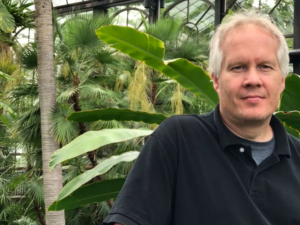 Kirk O’Riordan’s music has been referred to as “unapologetically beautiful” and is often praised for its uniquely “visual” qualities that depict a wide range of striking moods. His debut compact disk, Strange Flowers, was released by Ravello Records in November, 2013 and was praised by Audiophile Audition as “one of the most impressive and beautiful collections of chamber music I have heard in awhile….This is all just so lovely and invokes exactly the emotions that good music should be able to induce in all of us.” Gramophone Magazine praised O’Riordan as “a composer for whom imagery is a defining inspiration….[he] is a deeply sensitive composer who savours going gently into the night.” (April 2014).
Kirk O’Riordan’s music has been referred to as “unapologetically beautiful” and is often praised for its uniquely “visual” qualities that depict a wide range of striking moods. His debut compact disk, Strange Flowers, was released by Ravello Records in November, 2013 and was praised by Audiophile Audition as “one of the most impressive and beautiful collections of chamber music I have heard in awhile….This is all just so lovely and invokes exactly the emotions that good music should be able to induce in all of us.” Gramophone Magazine praised O’Riordan as “a composer for whom imagery is a defining inspiration….[he] is a deeply sensitive composer who savours going gently into the night.” (April 2014).
His recording of his Twenty-Six Preludes for Solo Piano—by pianist Holly Roadfeldt—has attracted similar praise: “are similarly atmospheric and proceed to unfold like a magical tapestry. Each of the 26 Preludes seemingly comprising of warp and weft forming a myriad of pixels of little pictures that ultimately combines to form a moveable feast for both eye and inner ear. O’Riordan’s miniatures are informed by languorous beauty and profundity, the lyrical variations of each often feature elaborate embellishments, as well as sudden dissonant figurations that seem to mimic the gravity-defying leaps of the gazelle…” (World Music Report, April 2017).
O’Riordan (b. 1968) is an active composer, conductor, saxophonist, and teacher. His music has been performed in Canada, China, Costa Rica, Cyprus, Finland, Italy, and Russia; and in thirty of the fifty United States. Performances of his works have been featured at the Ravenna Festival (Italy), the Indiana State University, University of North Carolina, Greensboro and Western Illinois New Music Festivals, the 2008 Eugene Rousseau Birthday Celebration, national and regional conferences of the Society of Composers, Inc. and the College Music Society; and in concert by such performers as the Eaken Piano Trio, Tresillo, The Moran Woodwind Quintet, Orchestra Bruno Maderna (Italy), the Arizona State University Chamber Winds and Symphony Orchestra, the Northwestern University Contemporary Music Ensemble, the Cleveland State University Orchestra, the University of Colorado Chamber Wind Ensemble, the University of Delaware University Singers, the Williamsport Chamber Chorus and Orchestra, the Susquehanna University Orchestra and Chamber Singers, The Lafayette College Concert Band, Contemporary Music Ensemble, and Percussion Ensemble, the SKIN Ensemble, Frederick Hemke, Timothy McAllister, Lawrence Stomberg, Marianne Gythfeldt, Kenneth Tse, Jeffrey Lyman, Emily Bullock, Steven Stusek, Andrew Rammon, Reuben Councill, John Perrine, and Holly Roadfeldt.
Kirk is the recipient of numerous awards as both a composer and a performer, including annual ASCAPlus awards, a Composer’s Assistance Program grant from the American Music Center, the 2001 Arizona State University Composition Competition, the 2000 Contemporary Music Society competition, and an ERM-Media Masterworks Prize. In addition, his Cadenza for Piano Trio was one of two works selected by audience members at the CMS Mid-Atlantic/Northeast Super-regional Conference for performance at the 2008 CMS National Conference.
Kirk’s music has been broadcast on WSMR, KBAQ, WQSU, and WVIA radio. Recordings of his works appear on the Crystal Records, Ravello, Centaur, ERM-Media and EnF labels, and feature performances by Kenneth Tse, Lawrence Stomberg, Marianne Gythfeldt, Holly Roadfeldt, Frederick L. Hemke, The Kiev Philharmonic, and Farrell Vernon. He has recently received commissions from AVIDduo, Saxton Rose, and Holly Roadfeldt. He recently completed his first opera: The Masque of Edgar Allan Poe, a one-act chamber opera based on Poe’s “Masque of the Red Death” on a libretto by Lafayette College colleague Lee Upton. The work was premiered by the University of Delaware Opera Theater in November, 2016 and subsequently at Lafayette College. Other projects have focused on music for dance: his River Lights for Orchestra (as recorded by the Kiev Philharmonic) was used by dancer/choreographer Ben Munisteri in his piece, Robot vs. Mermaid. O’Riordan has also collaborated with dancer/choreographers Carrie Rohman and Nandini Sikand. Recent projects include a concerto for Taiko Ensemble and Concert Band (for the Lafayette College Percussion Ensemble and Concert Band), incidental music for a Lafayette College Department of Theater production of Mary Zimmerman’s play Metamorphosis, and a new work for viola and piano for violist Michael Hall and pianist Holly Roadfeldt.
Dr. O’Riordan joined the faculty of Lafayette College in 2009, and now serves as Associate Professor of Music and Director of Bands, teaching courses in music theory, and composition. In addition, he teaches in the First-year Seminar program and conducts the Lafayette College Concert Band and Contemporary Music Ensemble. During his time at Lafayette, the Concert Band has been hailed for its ambitious and adventurous programming, having performed works such as Husa’s Music for Prague 1968, his own orchestration of Pictures at an Exhibition, and world premieres by O’Riordan, Ashley Kushner, Justin Kogasaka, Zach Jones, Pete Deshler, and William Pfaff. Previously, he served on the faculties of Bucknell University and Susquehanna University where he taught music theory, composition, music appreciation, and (English) writing. He has also served on the faculties of Lock Haven University, Colorado Christian University, Chandler-Gilbert Community College, and Paradise Valley Community College. He holds the Doctor of Musical Arts degree from Arizona State University (the first recipient of that degree from ASU); the Certificate of Performance in Saxophone from Northwestern University; and three Master of Music degrees (composition, saxophone performance, and conducting).
Kirk has studied composition with Rodney Rogers, Randall Shinn, James De Mars, Glenn Hackbarth, Jay Alan Yim, Burton Beerman, Marilyn Shrude, and Donald M. Wilson. He has studied saxophone with Frederick L. Hemke, John Sampen, Eugene Rousseau, and Iwan Roth. In his free time, Kirk is an avid fan of Obstacle Course Racing.